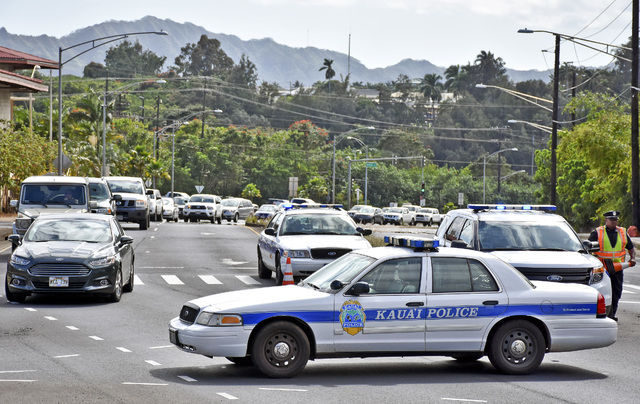LIHUE — The Kauai Police Department plans to reorganize its bureaus by converting nine of its 15 school crossing guard positions to training officers, safety monitors and background investigators. The shift is in an effort to minimize overtime costs and
LIHUE — The Kauai Police Department plans to reorganize its bureaus by converting nine of its 15 school crossing guard positions to training officers, safety monitors and background investigators.
The shift is in an effort to minimize overtime costs and to allow officers to focus responsibilities that often get pushed around among training sessions, heads of the department recently told members of the County Council.
KPD wants to turn nine of its crossing guards into three background investigators, two training officers and four traffic safety monitors. Currently, only three school crossing guards are employed with KPD: two at Wilcox Elementary School and one at Kapaa Elementary School.
The biggest concern for the councilmembers was the school crossing guard conversion to traffic safety monitors and training officers.
The department spends a total of $421,980 on overtime costs for 38 instructors every year teaching new recruits and training police officers for total of 6,492 hours, Deputy Chief Michael Contrades said.
The training — conducted by KPD detectives or patrol officers — usually has to be done in overtime because there is no designated training cadre, Contrades said.
Contrades said adding two new training officers would save the department a total of $174,800 a year.
A school crossing guard works one hour in the morning and one hour in the afternoon for $13.35 an hour and gets paid $7,299 a year, but a training officer would make $75,570 a year.
This would, in essence, create two additional training officer positions at $68,271 more than the school crossing guard would make, Councilmember Ross Kagawa noted.
Councilmember JoAnn Yukimura called the reorganization plan creative and said KPD was leading the charge in ways to be innovative when it came to restructuring bureaus.
She said it didn’t sound like KPD wanted to add positions, but was reorganizing the positions to make better use of them.
Contrades said KPD faces a problem when officers with the Investigative Services Bureau and Patrol Service Bureau are pulled from their roles to be assigned as instructors, which often creates shift disruptions among officers whose responsibilities are then put aside.
This typically occurs during KPD’s two yearly recruit classes and recall training, Contrades said.
He said detectives have “cases piling up,” responsibilities are pushed on to other officers and victims wait for return calls on their cases.
“That’s one of the concerns and complaints we’re looking to address,” Contrades said.
Yukimura said the plan made sense because the problem of “competing interests” sounded disruptive.
She asked Contrades and Chief Darryl Perry if they thought KPD could find instructors who were both “knowledgeable and versatile” to train officers.
Contrades said the department has been struggling with recruitment, but that it would properly train the individuals, so they could in turn train the recruits and officers in annual recall.
In regards to traffic safety monitors, Kagawa asked why it was necessary to have KPD monitor school areas when schools might be asked to do it with Department of Education funds.
According to Hawaii Revised Statutes Section 52D-7 (a), “the chief of police shall have charge, direction and control of all matters relating to preserving and protecting the public health, safety and welfare on and about the streets surrounding any school.”
Contrades said KPD interpreted that and decided it would create traffic monitors who would be able to enforce the law.
Four traffic safety monitors — with badges and insignias — would rotate around nine elementary schools across the island and replace the school crossing guards, Contrades told the councilmembers.
Six positions would remain — three of them currently filled — so the department can evaluate them for further reorganization, Contrades said.
Contrades said KPD will recruit from a pool of recent high school graduates, which would allow the department to start vetting for future police officers.
Traffic monitors will not be full-fledged police officers, but would be roving, lower-paid employees who would monitor areas around schools and collect data, then report to the traffic safety division, Contrades said.
Kagawa was not satisfied with KPD’s presentation on traffic safety monitors, stating that an 18- or 19-year-old would not be able to take on such a difficult responsibility at such a high pay of $55,980.
“What’s the difference between a starting police officer and traffic safety monitor?” Kagawa asked Contrades. “Why not just make them a police officer? If you need police officers, just make them a police officer.”
Contrades said the program is a new program that would allow KPD to get younger individuals familiar with KPD until they turn 21 and can become officers. Not all individuals would be under 21, he added.
Traffic monitors have the ability to enforce traffic laws and issue citations, whereas school crossing guards do not have that authority, county spokeswoman Sarah Blane said.
Traffic monitors won’t necessarily stand at the crosswalks — as school crossing guards do — but they could assist students in crossing the street if deemed necessary, Blane said.


